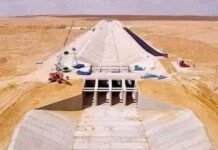The innovations in pump systems play a vital role in today’s agriculture. Modern agriculture can be defined as the interaction of sustainable energy consumption, water use, market conditions, and the application of experience and knowledge to ensure the best design for agriculture applications.
The understanding of past practices, current water and energy issues, and developments in pump technology comes into play when building pumping systems that best service the needs of modern agriculture.
Farmers can no longer rely on the technology and practices of the past due to the rapid change in the agricultural market.
That being the case, farmers should focus on profitability; energy optimization as well as better use of water resources. This is with a view to keep productivity high and stay competitive in the market. This is because pumping systems play a vital role in providing optimized solutions for energy and water use, especially in the case of irrigation.
Notably, a pump system for today’s irrigation must take into account the integration of variable speed drives, intelligent control and remote management. For instance, Grundfos can supply pumps that meet the low pressure and even flow requirements for uniform and efficient irrigation. The company’s pumping expertise and technology ensures uniform coverage. This is despite changeable conditions with pump efficiency optimized to reduce energy costs for running irrigation pumps.
Successful agriculture depends on farmers having sufficient access to water. Those living in the last century had the common perception was that water was an infinite resource. That, unfortunately, is not the case today, as it has been proven that water as a resource must be managed. As such, farmers must consider energy consumption. This is because energy for irrigation pumps is one of the highest single cost drivers for farmers. However, most are oblivious to the potential savings from more effective and efficient energy use.
Research has shown that modern agriculture requires irrigation solutions that optimize uniformity, reduce energy costs, safeguard the water resource and keep productivity at its best. Furthermore, the agricultural market changes require greater focus on applying knowledge, experience and total irrigation solutions integrating all components.
As such, Grundfos has produced the “Irrigation Pump Handbook“. This is a comprehensive presentation of modern irrigation today and what has gone before. The handbook explains why an irrigation system is complex and makes that complexity understandable. This, of course, is with a view to helping the owner and the installer make the right decisions when choosing a solution, from system layouts to our correct pump selection for irrigation systems.
Access to groundwater involves submersible or vertical turbine pumps. On the other hand, centrifugal pumps in different configurations, split case pumps and end suction pumps have been traditional solutions for surface water intake.
Generally, these pumps are required to meet changing conditions above and below ground. The conditions have an effect on the pressure and flow required from day to day and from season to season. Consequently, a pumping system must deliver the right amount of pressure and flow at the nozzle. This need can simply be met through getting an oversize pump. This will ensure the pump is able to handle a worst case scenario. Unfortunately, said pump will almost never operate at its optimal duty point. It will also produce too much pressure and consume too much energy.
Usually, water is distributed from the water source at low or constant pressure from pumps operating at single speed and delivered to the crop through nozzles. On these the focus is on surface coverage. On the other hand, pressure management remains an issue. Through the years, pressure reduction valves have been used to reduce pressure in the system. However, valves are costly to install and require frequent service and replacement, and their operation consumes a lot of energy.
Manufacturers such as Watertronics, in addition to being a market leader in pump and control innovation, has been able to match water supply with water distribution, as well as pumps with pivots. This has been implemented in the company’s Zimmatic pumping solutions. Powered by Watertronics technology, the Zimmatic solutions include not only pump stations, but advanced controls for high efficiency pumping that produces significant energy savings and labor savings.
Viable solutions
As a replacement for large, isolated pumps, use of complete pumping systems are the solution going forward. For instance, the costly and time-consuming use of pressure reduction valves to maintain constant pressure can be eliminated by investing in pump controllers for effective pressure management. This saves costs in the long term, while reducing the need for service and minimizing energy consumption.
A solar centered company like SunCulture has The SunCulture AgroSolar Irrigation Kit. This combines cost-effective solar pumping technology with a high-efficiency drip irrigation system to make it cheaper and easier for farmers to grow high quality fresh fruits and vegetables. The kit The Kit is designed to pull water from any water source using solar power. The solar panels provide the pump’s electricity directly without the need for expensive batteries or inverters. Water is pumped into a raised water storage tank during the day.
Farmers and pump system providers need to think through the specific irrigation applications in new ways. Particularly, they ought to think about irrigation system design in the application. The pumps must be much more integrated with the rest of the irrigation system. This means the pump must be designed to match the irrigation equipment or the irrigation equipment must be designed to match the pump.






I like the top pump systems for modern agriculture, It’s useable in Africa forest farming.I don’t know how much it going to cost me?